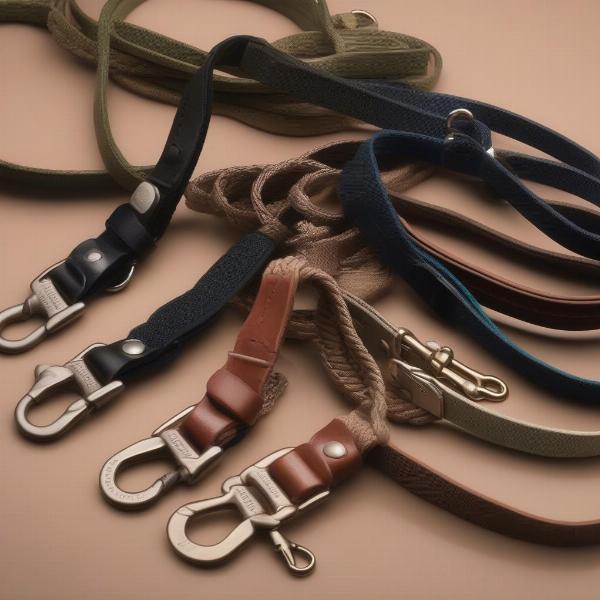Dog leads are an essential tool for every dog owner. Whether you’re taking your dog for a walk in the park, training them for obedience, or simply ensuring their safety in public spaces, the right lead can make all the difference. This guide will help you understand the various types of dog leads available, their uses, and how to choose the perfect one for your furry friend.
Types of Dog Leads
Choosing the right lead depends on various factors, including your dog’s size, breed, temperament, and training level. Here are some common types of leads:
-
Standard Leash: This is the most common type of lead, typically made of nylon, leather, or rope. It comes in various lengths and widths. Standard leashes are versatile and suitable for everyday walks.
-
Retractable Leash: These leads allow for more freedom for your dog while still providing control. However, they can be dangerous if not used properly, as they can cause burns or injuries if the cord snaps back. They are also not ideal for training.
-
Slip Lead: A slip lead tightens around the dog’s neck when pulled, providing control but also posing a choking hazard if misused. These leads are best used by experienced dog owners for training or handling. slip leads for dogs
-
Long Line: These leads are typically 10-50 feet long and are great for training recall or giving your dog more freedom in open spaces. They require careful handling to prevent tangling. recall training leads for dogs
 Different Types of Standard Dog Leashes
Different Types of Standard Dog Leashes
Choosing the Right Lead for Your Dog
-
Size and Breed: Larger, stronger breeds require sturdier leads made of durable materials like strong nylon or leather. Smaller breeds can use lighter leads, but ensure they are still strong enough to handle unexpected pulls. extending lead for strong dogs
-
Temperament: For dogs that pull excessively, consider a front-clip harness or a no-pull lead. These can help discourage pulling behavior.
-
Training Level: For puppies or dogs undergoing training, a standard lead or a short training lead is usually best. Avoid retractable leads as they can hinder training.
-
Activity: For activities like hiking or running, a hands-free lead that attaches to your waist can be convenient.
Lead Training Tips
Proper lead training is crucial for both your dog’s safety and your enjoyment of walks together.
-
Start Early: Begin lead training as early as possible, ideally when your dog is a puppy.
-
Positive Reinforcement: Use positive reinforcement techniques, such as treats and praise, to reward good leash manners.
-
Consistency: Be consistent with your training and expectations. Use the same commands and cues each time.
Maintaining Your Dog’s Lead
Regularly inspect your dog’s lead for wear and tear. Replace any leads that show signs of fraying or damage. Clean your lead regularly to prevent the build-up of dirt and bacteria.
Beyond the Lead: Off-Leash Adventures
While a lead is essential for most walks, off-leash time can be beneficial for your dog’s physical and mental health. However, this should only be done in safe, designated areas where your dog has excellent recall. best dogs off the lead
Conclusion
Choosing the right dog lead and implementing proper training techniques are essential for responsible dog ownership. By understanding the different types of leads available and considering your dog’s individual needs, you can ensure enjoyable and safe walks for both of you.
FAQ
- What is the best type of lead for a puppy? A standard lead is typically the best option for a puppy as it allows for good control and helps with training.
- Are retractable leads safe? Retractable leads can be dangerous if not used properly. They can cause burns or injuries if the cord snaps back and are not recommended for training.
- How long should a dog lead be? The ideal length depends on your dog’s size and training, but 4-6 feet is a common length for standard leads.
- Why is lead training important? Lead training is crucial for your dog’s safety and allows you to enjoy walks together without pulling or other unwanted behaviors.
- How do I clean my dog’s lead? Most leads can be cleaned with warm soapy water. Check the manufacturer’s instructions for specific cleaning guidelines.
- When can I let my dog off the lead? Only let your dog off-leash in safe, designated areas where they have demonstrated reliable recall.
- What if my dog pulls on the lead? Consider a front-clip harness or a no-pull lead to discourage pulling. Consult with a professional dog trainer for specific advice.
Expert Insights:
-
“A well-fitted and appropriate lead is the foundation of a positive walking experience for both dog and owner.” – Dr. Emily Carter, Veterinary Behaviorist
-
“Never underestimate the importance of consistent lead training. It builds a strong bond and ensures safety.” – Mark Johnson, Certified Dog Trainer
-
“Choosing the right lead is like choosing the right shoes for a marathon. It can make or break the experience.” – Sarah Miller, Professional Dog Walker
ILM Dog is your trusted source for expert advice on dog care and training. We offer a wide range of resources on dog breeds, health, nutrition, and behavior, helping you provide the best possible care for your canine companion. From puppyhood to senior years, we’re here to guide you every step of the way. Contact us today for personalized advice and explore our comprehensive resources at ILM Dog. Email: [email protected], Phone: +44 20-3965-8624.